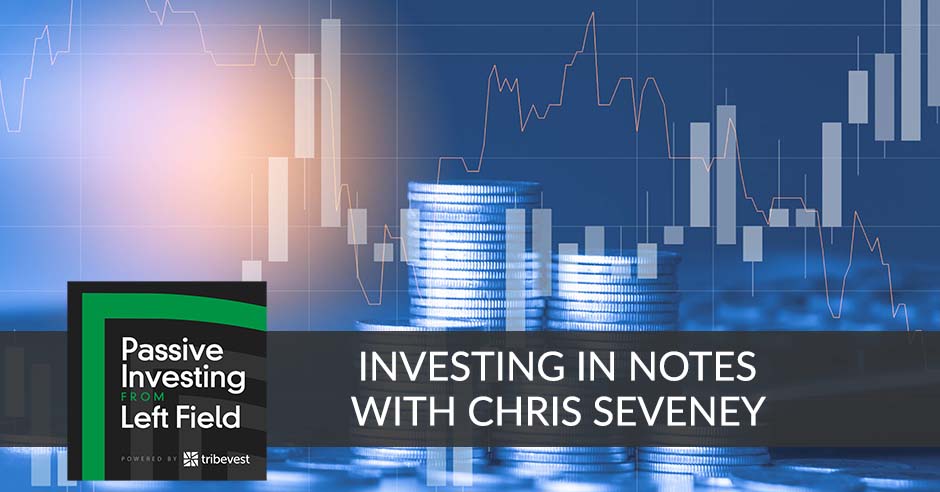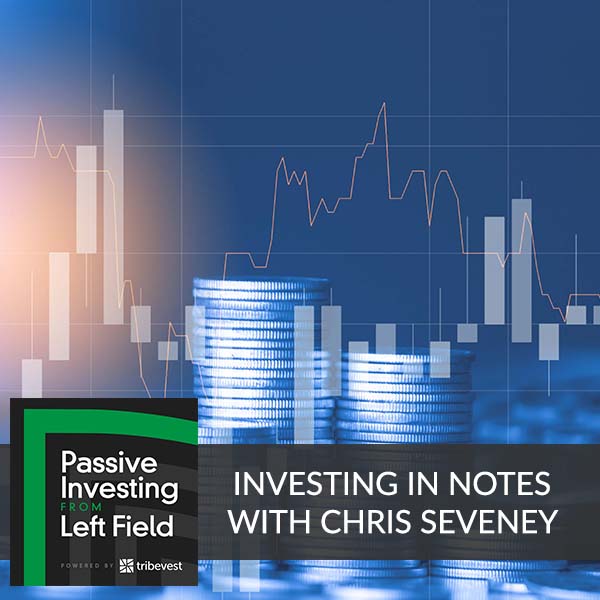
Are you interested in making money while having a positive social impact? Many real estate investments improve properties, so their tenants have a nice place to live. Note investing takes this a step further and works to keep homeowners who have defaulted on their mortgage in their homes. The banks love it because they get bad debt off their books, the homeowners love it because they get to stay in their home and the investors love it because they earn a return as the notes are converted from bad debt back into performing notes. Join Jim Pfeifer as he interviews Christopher Seveney from 7E Investments on the ins and out of note investing! This episode is packed with information to help you understand notes, mortgages, collateral and much more – tune in to learn how to become a note investor!
—
Listen to the podcast here
Investing In Notes With Chris Seveney
I’m excited to have Chris Seveney with us. He brings over many years of real estate experience to 7EInvestments and has been actively buying and selling mortgage notes since 2016. This conversation was mostly about those notes. Chris, welcome to the show.
Jim, thanks for having me. I’m excited to be here.
The first question I always ask is, what’s your journey? How did you get into real estate? More specifically, how did you get into notes? If you can tell us how you got here, that would be great.
Stepping back into real estate was what I went to college for. I went for Civil Engineering. In my senior year, I made a little bit of a switch because I was thinking I was going to be more on the design side when I realized designing bridges for the rest of my life or something didn’t seem that fun. I flipped over to construction management in my last year as part of the Civil Engineering program. I got into that. I was working for a general contractor for about ten-plus years until you get into your mid-30s and get burnt out from working six days a week. I went over to the dark side, which was with a developer. It was the first thing I was working on with a developer.
He said, “What’s in your own portfolio?” I said, “Nothing.” He said, “We got to change that pretty quick.” He goes, “Have you ever heard of the 40/40/40 rule?” I said, “What the heck’s a 40/40/40 rule?” He goes, “You work 40 years for 40 hours a week to only be able to afford about 40% of the lifestyle you were living.” I was like, “Whoa.” That opened up my eyes and made me laugh because we used to have a 40/40 club of 40 home runs and 40 stolen bases back in the day. I started buying some rental properties, my wife and I. We were doing the BiggerPockets‘ BRRRR strategy. We had kids, and it was too overwhelming, especially being in the Washington, DC, area of the amount of cash you need.
My wife and I decided, “Let’s stop it for a little bit.” Me being an entrepreneurial, I was going on BiggerPockets. First, I saw tax lien, so I started playing with those a little bit but realized it was boring to me. There was nothing behind it. There’s a strategy, but not compared to when I found note investing, which we’re going to talk about. Once I found out you could do note investing, I was a little upset because I didn’t realize this business even existed. I knew there was private lending, but not this side of note investing. That’s my journey through that process.
That’s interesting. I haven’t heard the 40/40/40 rule before, and it is so true. With 40% of your living expenses, no one wants to live like that. You work these 40 years of a long career and realize when you get there, “Maybe I’m not there.”
Thankfully, my father worked for a school system, so he had a pension, but how many people do you see nowadays in their mid-60s who did very well throughout their careers but all of a sudden they’re like, “I still can’t retire comfortably?”
Maybe the ones that have to go back because the market tanks or whatever, and now you’re a Walmart greeter or whatever the cliché is. You see it. There’s no way to go. Notes are what got you out of the 40-hour work week in that place that you were. How did you figure out notes? I was digging around BiggerPockets. I was a turnkey investor, and I finally found what I’m passionate about, which is passive investing. You found what you’re passionate about is notes. How did you find that? How did you jump from the BRRRR or the tax liens and figure out, “Notes is for me?”
I left my full-time job to do notes, but I was doing it for 4 or 5 years. I was working while doing notes. What attracted me to notes was several things. One is you can do it from anywhere as long as you have an internet connection. You can do it anytime during the day. You’re not competing against people like a property comes on the market, and you got to get your offers. Notes levels that playing field because you’ll get a list of assets for sale, and they say, “We need bids by Friday. It’s in a week.” It’s not like you’re running out there and you don’t have time, and then you miss the boat. That was one of the key factors.
You can do it anywhere at any time during the day. I could work my day job and spend time with my kids and my wife if she goes to bed earlier than I do. I used to call myself the midnight to 2:00 investor. Late night, I was doing my entrepreneurial “side gig.” That’s what drove me. Plus, I come from a family where when I was growing up, my parents adopted four kids who were from a bad family. I’ve always liked to help people or try and help people.
With note investing, you have that opportunity to work with people because you’re buying loans at a discount to try and keep them in their house if they want to, in proverbial, play ball. If they’re willing to work with you, you can work with them in most instances to try and keep them in their homes. We’ll talk more about notes, but one of the things that I think most people don’t realize with note investing is investors, a lot of times, will go to try and foreclose on these assets to try and get the property, but it’s much more profitable at the end of the day to keep the people in their homes.
[bctt tweet=”With note investing, you can work with people because you’re buying loans at a discount to try and keep them in their house if they want to. ” via=”no”]
Let’s dive in here. What are notes? It’s a mortgage on somebody’s house. Talk to us about the notes and the different kinds of notes, and give us an overview from the start.
Like you mentioned, when people buy a house, typically, people are not paying cash for that house. There are two documents they sign. Most people, even myself, always thought they were the same. You sign a note and a mortgage or a deed of trust. They are intertwined together. The difference between the two is the note is the IOU. The note says, “Jim, I’m giving you $100,000, and you’re going to pay me $600 a month for the next 30 years at 6% interest.” It’s the IOU. The mortgage is the teeth behind it. The mortgage is that legal document that says, “Jim, if you don’t pay Chris, Chris has the right to go after the property as collateral.”

That’s the difference between a note and a mortgage, but they’re intertwined because they’re always hand-in-hand together. If you get a car loan, it’s typically secured, but there’s unsecured debt, which is credit cards. Mortgages and notes are secured. There are different types which are first position and second position. The best way to think about it is you’re in line. You want to be first in mind, meaning that if that person stops paying, you’re the first one to get paid. With the home equity line of credit, you see a lot of people getting those now because they’ve built up so much equity. Those are inferior to your first mortgage, so those are called seconds. Another name, as I said, is a line of credit.
With notes, there’s performing where people are paying. There’s also nonperforming, where loans are typically 90 days or more delinquent. One thing I want to mention about that is most people think like, “I missed a mortgage payment. They’re going to come to throw me out.” Most of our borrowers are behind by 3, 4, 5, or 6 years. It’s not like if somebody misses a payment, we’re foreclosing on them. With the laws nowadays, you can’t even do anything to the borrowers at least 90 days past due. I wanted to throw those out there as well the difference between a performing and a nonperforming loan. We primarily focus on the nonperforming side.
You mentioned that the second mortgage, the home equity line of credit, is inferior to the first. Can you explain exactly what that means, that it’s in the second position?
Let’s say I lent you $100,000. Let’s say your house appreciated $150,000, and you go out and take a $25,000 line of credit. Now all of a sudden, something happens, values decrease, and plus, you didn’t take care of the property. Let’s now say that the property’s only worth $90,000 and gets sold at a foreclosure sale. It’s not like each person gets a percentage. It’s like, “There was $150,000. We get $90,000.” We’ll split it or give people percentages of things. It’s like if you and I went in and bought something, paid $10 apiece, and sold it for $8, we’d each get $4 and lose $1 apiece.
This is the first position. We get all of that money, and once they’re satisfied or paid off, if there are additional funds, it goes to who’s next in line. If there are not any funds to go to that person, like the second line of credit, they get completely wiped. They lose everything. The second line of credit or seconds has a much higher risk when you’re investing in them, especially in nowadays economy, where I think most people agree that houses are starting to get a little soft.
You talked about performing and nonperforming. Can you dig into that a little bit and why one is maybe better than the other as an investor? Can you explain those a little bit more?
It depends on your business model and your risk. With performing loans, the borrowers pay every month. As a passive investor, there’s a lot less work that is involved. I will tell anybody that if you’re investing in notes or even private lending because technically, you’re originating a note, it’s passive but active. You still have to do work. I don’t want people to think that it’s just like, “I don’t have to do anything.” The only time I’d say you pretty much don’t have to do anything is when you’re investing in a fund, in which you have to do all that due diligence upfront. On the performing side, you hear the term mailbox money, where people start paying, and you’re getting that payment every month.
Your returns are typically lower. If you’re buying performing loans that at one point in time had some delinquencies or poor credit, you might see returns between 8%, 10%, or maybe 11%. It might be able to get into that double-digit range. With nonperforming, you got somebody who hasn’t paid for three years. You’re buying that loan at a substantial discount, probably like $0.50 on the dollar. We typically now pay $0.40 to $0.60.
A few years ago, we were probably paying $0.30 to $0.50. Pricing has gone up because inventory levels on distressed notes have gone down. People ask, “How do you make money on something that isn’t paying?” That goes back to where that mortgage comes in handy, where you can enforce the mortgage by filing a complaint against a borrower to say, “Pay up. Let’s work out a deal, or we will have to look toward redeeming that property through foreclosure or other means.”
Why would a lender sell a performing note? Sometimes I get a mortgage, and it gets sold off, and I have another servicer. I understand getting the nonperforming notes off the books, but why would you sell a performing note?
It depends. A lot of investors who we buy from and funds look to balance their portfolios. For us, we like to keep between 30% and 40% of our portfolio performing and 60% to 70% as non. If those balances start getting up to 50/50, we may try and liquidate some performing and get some cash in to buy additional nonperforming assets. It could be for fund balance or portfolio balancing. It could be they just need cash for something else. Some investors also might be looking at a multifamily deal or another type of deal.
It’s easiest to liquidate performing assets because there are a lot more people who are interested in a performing asset than there is a nonperforming assets. A lot of people think, “There must be a problem with it.” There are many different reasons why people sell things. You may have a good rental property in your portfolio that has been an awesome rental for you, but it might have capped out its value, for example, or you have another deal you want to go to, so it’s like, “Let’s sell this asset to use those funds elsewhere.”
When you have a nonperforming note, the goal is to rehab that to make it performing. How do you go about that? What are the steps that you take to make it a performing note again?
One of the keys to investing in nonperforming notes is your team around you. In my company, we don’t physically call the borrower and try and work something out. The first line of defense is what’s called a loan servicer. That’s a company that collects the payments. Lo and behold, whoever’s reading who has a mortgage, you’re paying a loan servicer. It could be owned by your bank or lender.

Typically most of them are third parties that they “white label” for your bank. They’re the first line of defense. They’re collecting payments but also doing that initial reach-out. They’re trying to get on the phone with the borrower and work out some type of payment plan agreement like forbearance. There are a lot of terms. It’s basically trying to work out some type of agreement to get them paying again. That’s the first line of defense.
If they can’t get through or can’t work something out, the next line is an attorney. We’ll use an attorney who will first send what’s called the demand letter, which is a letter demanding payment. A lot of times, that is where the rubber meets the road because when people aren’t paying, a lot of times, they won’t answer the phone, and the letters they get in the mail from their servicer, they probably don’t even open them because they’re like, “Another statement. Let me just throw it away.”
Once they see something from the law offices of XYZ, they’ll be like, “I better open this.” That starts the process where they’ll usually call the attorney at that point in time. That’s when we usually start seeing it. We have that attorney send that letter earlier on. We give the servicer 30 to 60 days to try and make communication. If they don’t, we’ll usually have the attorney send that letter.
What’s the process when you buy a nonperforming note? It’s someone else’s problem, you bought a problem, and now you got to fix it. Is that where you start to give the servicer 30, 60, or 90 days to figure it out and start on the attorney? If this is a deal that’s six years, and they haven’t paid their mortgage, are you jumping right to the attorney?
By law, you have to give the individual 30 days. Once a loan gets sold and transferred to a servicer, there’s a 30-day period where a borrower can technically dispute it. If they dispute the debt and you had that letter sent, you have to reply to that letter and start to process it all over again. We usually wait for 30, 45, to 60 days. This blows my mind, and this will probably blow your mind too. People can’t fathom this because a lot of investors know every single asset they own and so forth and can tell you what color paint is on the walls. With a lot of these funds, they’re buying thousands and thousands of loans. The cost to manage a $500,000 loan and a $50,000 loan is exactly the same.
It’s the same servicing cost, foreclosure cost, everything. They focus on the top tier of the most-priced loans. I’ve had loans where they literally sit in a draw, and nobody has reached out and contacted. Nobody has even tried to contact them for years. All of a sudden, I’ve had loans where the servicer picks up the phone and calls and is like, “I’ve been trying to figure out who to send my payment to. I didn’t know where to send it because a loan’s been sold many times.” Another one we see a lot is bankruptcy. In Chapter 7 bankruptcy, the borrower technically doesn’t owe you the money anymore. They’re thinking, “I get a free house.” That’s not the case. You don’t have to pay it anymore, but the lender can now take the house, or you work out an agreement.

A lot of times, the borrowers just think, “I don’t have to pay.” After that happens, the servicer can’t contact the borrower because what do they call them for? They don’t owe them any money legally because the debt’s wiped. You’re forced to start legal. A lot of times, some of these companies will look at it and be like, “We’re not starting legal yet.” It sits. I’ve had in the last year three occasions where I’ve had our attorney reach out to the borrower’s attorney that was in Chapter 7 and said, “Does your borrower know that they don’t owe the money, but if they want to keep the house, they got to work out a new payment plan on that old loan?” and they’re like, “Let me get in touch with them,” and they do. Lo and behold, we work out new agreements.
We can work with them on the late fees and some of this other stuff a lot of times because it’s part of negotiations with them to get them paying. It blows my mind that there are a lot of loans out there. I’ll mention this too. There’s a nationwide bank that’s one of the largest banks in this country that when the COVID came through, there were certain loans you could foreclose on and certain ones you could not. They ceased doing anything because they couldn’t figure out which loans they were allowed to foreclose on and which ones they couldn’t. We’re talking about one of the largest banks in the country.
That’s incredible. I still have trouble understanding how someone can go 3, 4, 5, or 6 years and not pay their mortgage. This is going to sound bad. How long can I stop paying before someone comes after me? I thought, like you said, a month or two if I don’t pay my mortgage, someone’s coming to take my house. What’s the average length of time a note is nonperforming?
It depends on the investor. The typical process can be anywhere from 6 months to 18 months is what foreclosure would take. There are two types of states. There is a judicial state, which means you have to go through the court, and there is a non-judicial state. That means you don’t have to go through the courts. Believe it or not, 90% of them are broken up by red versus blue states without getting into political dissension, except for California, which is a state that isn’t too bad. You’d think it would be based on how it liens. New York, for example, takes five years. You go down to Georgia, and you’re 60 days. You can see the big gap.
It really depends on the lender itself and if they are managing that file. What happens is they get six months behind, they get that demand letter, and it’s like, “Let me work something out.” You’ll work out some type of payment plan over a six-month period. 2 to 3 months go by, and they make 2 to 3 payments and stop paying again. It’s like, “Let me try another plan or whatever.”
The question is, how many times when that plan do you give them and then all of a sudden, next thing you know, they’re 10 or 12 months behind, then enough is enough sometimes where they have that repeated process of not being able to pay? It blows my mind sometimes how long some of these loans have gone 3, 4, or 5 years sitting there. The longest one now we have in our portfolio goes back to 2011, which was the last time the borrower made a payment.
There are a few things I like about note investing. My favorite thing other than it gives you a nice return is it’s one of these things where you can help people and make money at the same time. You said your goal is to keep people in their homes. How does that work when you’re rehabbing a nonperforming note to make it performing? What negotiations do you do? How do you keep them in their homes, so they don’t get foreclosed on?
Here’s an example of a deal we reached with a borrower. The mortgage was from 2012. The balance on loan was about $80,000. They were paying about $900 a month. It’s a woman whose spouse passed away. She had a loss of income that was helping contribute. We were able to acquire that loan for about $50,000 is what we paid. That’s $0.62 on a dollar. The borrower was about 15 to 18 months behind roughly if I recall. We reached an agreement with the borrower to re-amortize the loan. I don’t think we’ve ever increased an interest rate on a borrower. Typically, you don’t also increase the payment. The goal is to try and lower the payment.
We dropped that $900 payment down to $700 a month of what the borrower could afford. It doesn’t make sense sometimes to be like, “I’ll drop it from $900 to $850,” and the borrower says, “I can’t afford that.” If the borrower can’t afford it, you’re just wasting time. To let people know, time is very important. Time is money in note investing. You want to try and come to some type of resolution ASAP because time is money. We dropped the payment down to $700 and did what’s called a forbearance plan, which is we’re basically pausing any legal action and giving her a trial payment plan of, “If you make this over this $700 over six months, we’ll modify the loan, which means we’re permanently going to change the loan to that lower payment.”
What that does is it gives us flexibility during that trial payment period. If they falter, the old term still applies. If they were to falter, we could still say you’re eighteen months behind. If I modified the loan first, that’s starting over, so I’d have to wait 90 to 120 days until they fall behind again. That’s one way we help people by taking those past two sometimes and rolling it into the end of the loan. In many instances, we’re typically taking that principle and interest payment and trying to knock that down because the borrowers can’t afford it.
A lot of times, there’s a reason why. They may have temporarily been laid off, got sick, or had a family lost. We try and paint that picture when we’re reviewing these loans and have them under due diligence to try and understand what that problem is. At that point in time, we’re already working like, “What’s our exit plan so we can run our numbers off of that exit plan to make sure the numbers still do work for us as well?”
You can lower the payment on that loan because it’s not an $80,000 loan to you. It’s a $50,000 loan because you bought an $80,000 loan for $50,000. That’s where you can make your money still. It’s a win-win. The person stays in their home, and you make money.
One thing I’ll mention to people who read this, too, is to remind people we’re not buying the house. That’s a question we get asked a lot. “You own the property.” No, we don’t own the property. We’re just the lender. We’re stepping in. I’ll use Wells Fargo’s name as an example because everyone knows who they are. Instead of you paying Wells Fargo every month, you’re paying Seveney Investments every month. You don’t call Wells Fargo to fix your roofer and unclog a toilet.
Interest rates are increasing, and inflation is here. Uncertain times are coming. No one knows what’s going to happen. As interest rates rise, what does that do to this industry of note investing? Are there going to be more nonperforming notes? If there’s an economic downturn, is that good for note investors? I know it’s not good for everybody, but is it good for note investors because more loans will go bad? Is it bad for not investors because you have some loans that will go bad, most likely? Is it both?
It’s going to be both. There will be loans that we had that were performing that most likely will go into default, which happens all the time. Whether a good economy or bad economy, stuff happens to people all the time. That’s part of it. It’s interesting because we get asked this question ten times a day, especially from investors looking to invest with us. The interest rate now, where it’s at from a note perspective, is somewhat interesting because we’re not originating new loans. It’s not like we originated a loan six months ago at 4%, and now, all of a sudden, it’s at 7%. We can’t sell that, or we’re selling it at a bigger discount.
As you said, with the inflation and the loss of jobs, we will see more distressed borrowers. We’re at an all-time low in history for the number of people who have defaulted on their loans. We’ll get back to normal. We’re not going to get to 2008. Personally, I don’t see that happening. When that happens, it’s a supply-demand business. If supply goes up, there’s probably a little less demand because more investors have gotten out over the last few years because of the lack of inventory. We’ll start to see pricing like that loan I just mentioned, that $80,000 note we paid $50,000 for. Forty-five years ago, I probably would’ve paid $40,000 for that loan. It’s probably going to go back to somewhere probably in between where it’s not $50,000. It’s probably $45,000.

The benefit of that is it also helps us a little bit. It gives us more flexibility in working out with some of these borrowers. At the end of the day, if you have to foreclose on the property, it’s usually not in the greatest condition. You have to clean it out, pay the agent, and foreclose all that process. You’re losing probably 25% of that value during that time. Whereas if I can keep them paying and get a nice double-digit return on it, it’s that win-win. By more delinquencies, will it help us? Yes. It might give us a little better returns, but it also gives us the ability to also work more with a borrower where instead of $700, maybe I could go to $650, where in the past, I couldn’t.
Our community Left Field Investors, is passive investors, and we’re always looking for new opportunities and new asset classes. We believe you have to vet the sponsor first and the deal or the asset class or the market. How does someone vet an operator like you? How do we know that you know what you’re doing? How do we build that trust? Aside from developing a relationship, what are some of the questions we should be asking note operators?
I’m an investor as well. We’ve put together Questions You Should Ask Any Sponsor. It’s on BiggerPockets. You can download it. The first question I always ask people is, “Send me a sample of your monthly or quarterly report and a sample like a balance sheet or financials that you provide to investors.” That’s the first thing I always ask. With this being done, there’s in the news in a different industry a balance sheet came out about a billion-dollar company filing bankruptcy. The balance sheet was a joke, I guess. I looked at it and chuckled. The first thing I typically ask is, “Show me what you send people.” If the person can’t show you anything, that should be a red flag. I like to think I treat people’s money like it’s my own.
The only way to do that is to watch it like a hawk, have your books done, have a balance sheet, and have the reporting out to people. Show people how you do that. There are some websites out there. I know a lot of people use Verivest, for example. The interesting thing is I tried to get on Verivest, and because of the type of fund we have because we have a Regulation A plus offer, which has to go through the SEC, versus the Regulation Ds, which are exemptions, Verivest told me like, “We don’t take Regulation A offerings. You’ve already gone through the SEC.” I was like, “Okay.” It’s a good marketing thing to have people say, “I’m Verivest verified.”
I’m just using them as an example, but I know other fund managers who have gone through them. The balance sheet is the first one. There are the typical common questions of, “Are you currently being sued?” Try and get a background check on somebody. Have they ever filed for bankruptcy? PACER is a site where all the bankruptcy filings are all public, so you can look up people to see if they’ve ever filed for bankruptcy. I recommend you always pull some type of background check or skip trace on anybody. A lot of passive investors in real estate have owned rentals at one time. Think about the amount of due diligence you do on that renter who may be paying you $1,000 a month, and you’re looking to give somebody $100,000. A lot of people do more research on that renter than the person they gave the money to.
[bctt tweet=”Always pull some background checks or skip a trace on anybody. ” via=”no”]
That is a great point. You’re absolutely right. Talk about your fund. I know it’s different because it is Regulation A. Also, there’s some difference in taxing. Whenever I do note investing or private lending, I like to do it out of a non-taxable account, like a self-directed IRA or something like that, because you have to pay taxes on this stuff. There is a depreciation and some other benefits. You guys have an interesting outlook or interesting setup on that. Can you talk about that?
First, I have to give the standard caveat. I can’t give you tax or financial advice and all that fun stuff. I’ve run other funds in the past and also owned notes in my portfolio. It’s the dreaded ordinary income K-1. If the fund were to take on any type of debt, then you get the UDFI/UBIT type stuff. When we’re going through this, originally, we’re looking at a restructure, which we couldn’t do, or it’s not tax-beneficial to do a REIT because REITs are meant to be passive where we’re buying distress notes. I’ve spent an entire weekend reading Tax Code on REITs and had to throw it out. We end up doing a C corporation, which everyone knows what a C corporation is.
By doing that, it should allow anyone investing to A) If you’re using an IRA, avoid any UBIT/UDFI because it’s a C corp. We’re paying that corporate tax rate as part of the distribution. We’re absorbing that tax. The other half is you’re a shareholder in the company, so it’s like you’re buying Apple stock, Google stock, or any other stock where if you hold it for a certain period of time, you’re at that dividend rate versus that ordinary income rate. I joke to people that we start at $500 investment minimum, and it’s non-accredited or accredited. We tell people, “If you have an eighteen-year-old kid, they can throw $500.”
We’ve done videos to show 8% at a dividend rate is better than 10% at a 37% bracket. For investors, if they invest more, they can get up to a 10% return, which is better than the typical 12% that a lot of people will see on the hard money side. We’re getting too much in the numbers, which is tough to understand over an interview. My point is people should look at the structure. You look at the net, not the gross.
[bctt tweet=”People should look at the structure because you look at the net, not the gross.” via=”no”]
That’s a great point. I don’t believe you can get this, but you talk to some financial advisors and say you can get 8% to 9% returns on your stocks or mutual funds. Maybe you can, but when you have to pay tax on it, are you better off at 7% in a real estate deal where you’re not paying any taxes? The same thing here is you have to factor in taxes because that’s the biggest eroder of wealth. It’s neat that you’ve built in a lower taxable situation for notes because, in the past, it was either notes in your self-directed IRA or you don’t do notes because you don’t want to get taxed on it. This allows people to get into the lower tax rate. That seems like a pretty good deal. The last question I always ask is, what is a great podcast you listen to? Give me the name of yours, and you can’t pick that one.
Ours is the Creating Wealth Simplified Podcast. I like to listen to the All-In Podcast. Another is Tribe of Millionaires, which is part of a group called GoBundance. That is another good podcast as well. Those are pretty much the two. I jump around a lot. Lately, I’ve been doing a lot more YouTube stuff than I have been on the podcast side of things. I’m going to take some time off, and I’ll be hanging out by a pool because we’re heading to somewhere much warmer than the Washington, DC, area and listening to some other podcasts.
That’s awesome. Thank you for those recommendations. Have a nice trip and enjoy the warm weather. If people want to get in touch with you, what’s the best way they can do that?
They can go to our website, which is 7EInvestments.com, or email me at Chris@7EInvestments.com. You can go on Google and google Seveney Mortgage Note Investments. You’ll find us there as well.
Thank you very much for being on this. This was great. It was good learning about notes and trying to understand this asset class, so we appreciate you.
Thanks for having me on. People, if you have questions about note investing or anything, feel free to reach out. We’re always happy to provide people with some information and feedback on things. We don’t sell any courses or anything like that. We’re always happy to answer questions that people have.
Thank you very much, and have a great day.
Thanks, Jim. Everyone, thanks for reading.
—
I learned a lot about notes in that conversation with Chris. I also learned some other stuff. I love the 40/40/40. You work for 40 years, 40 hours a week, and end up with 40% of your living expenses as what your income is. I don’t like that, but it was an interesting way to look at it. As part of Left Field Investors, a lot of people’s goal is to make that 40 years and 40 hours a week optional because you have other income streams. That was neat to hear him say that. Another thing about the note and the mortgage is I do private lending, and there’s always a mortgage, a promissory note, and a personal guarantee.
I always get confused about what does what, but he did a good job explaining where the note is basically the IOU and the mortgage is where the collateral is. That’s where the hammer comes down if you don’t pay. If you don’t pay, the mortgage comes in, cleans you up, and takes care of you. I like these investments because, as Chris said, the goal is to keep people in their homes. In real estate, we’re trying to provide safe places to live or work. There is a lot of community benefit and benefit to society of being in real estate.
Note investing is one of the places where it is the most visible because you buy a note that’s not performing, and instead of just evicting the person, you work with them and try to get them to stay. It’s a win-win. The homeowner wins because they get to stay in their house, and they’re maybe paying a little bit less. The note holder wins because they’re converting a nonperforming note into a performing note. Even the original bank wins because they write off that original note that they weren’t going to get paid anyway, so they’re done with it and can move it off their books.
It’s a way that you can invest and make money and also help people, which is always something that I like to do. Talking about screening sponsors and asking for reports, this is basic, but a lot of times, we don’t do it. “What do you send your investors every month or every quarter?” Ask for one of those. “I’d like to see one before you invest.” Why would you not do that? As Chris said, people spend more time vetting the tenant that’s going to move into their rental that’s going to pay them $1,000 a month, maybe. They spend more time vetting that than they do to a sponsor where you’re going to wire them $50,000 or $100,000. It makes sense. Ask all the questions. Don’t be afraid to ask. If you don’t get the answers, move on. There are plenty of people in this business and plenty of operators that are high quality and communicate well, and you can build relationships with those people. I love hearing that from Chris. That’s all we have for this time. We’ll see you next time.
Important Links
- 7EInvestments
- BiggerPockets
- Questions You Should Ask Any Sponsor
- Verivest
- PACER
- Creating Wealth Simplified Podcast
- All-In Podcast
- Tribe of Millionaires
- Chris@7EInvestments.com
About Chris Seveney
 Christopher Seveney brings over 25 years of real estate experience to 7E Investments and has been actively buying and selling mortgage notes since 2016. During this time, he has acquired over 500 notes with UPBs in excess of $25 million in over forty states. Prior to investing in mortgage notes, Chris built a multimillion-dollar portfolio of assets through new construction and rehabilitation of existing properties in his own portfolio along with having managed over $750 million in new construction in his 25-year professional career.
Christopher Seveney brings over 25 years of real estate experience to 7E Investments and has been actively buying and selling mortgage notes since 2016. During this time, he has acquired over 500 notes with UPBs in excess of $25 million in over forty states. Prior to investing in mortgage notes, Chris built a multimillion-dollar portfolio of assets through new construction and rehabilitation of existing properties in his own portfolio along with having managed over $750 million in new construction in his 25-year professional career.
Our sponsor, Tribevest provides the easiest way to form, fund, and manage your Investor Tribe with people you know, like, and trust. Tribevest is the Investor Tribe management platform of choice for Jim Pfeifer and the Left Field Investors’ Community.
Tribevest is a strategic partner and sponsor of Passive Investing from Left Field.








